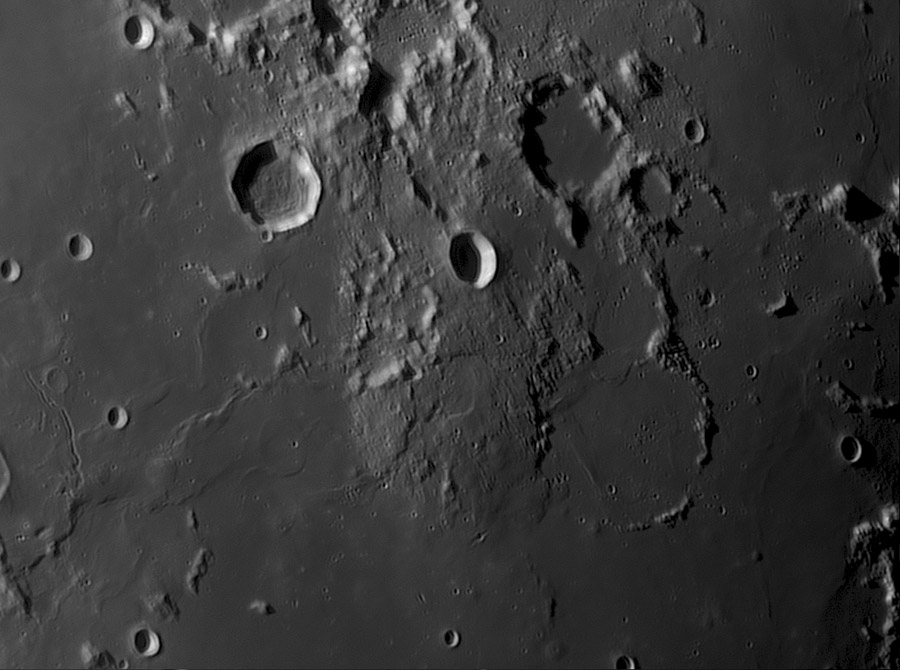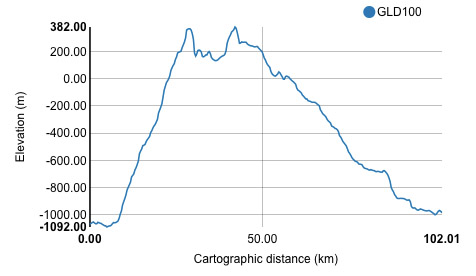Difference between revisions of "July 28, 2014"
| Line 9: | Line 9: | ||
<td><!-- ws:start:WikiTextLocalImageRule:15:<img src="/file/view/LPOD2.jpg/517162700/LPOD2.jpg" alt="" title="" /> -->[[File:LPOD2.jpg|LPOD2.jpg]]<!-- ws:end:WikiTextLocalImageRule:15 --><br /> | <td><!-- ws:start:WikiTextLocalImageRule:15:<img src="/file/view/LPOD2.jpg/517162700/LPOD2.jpg" alt="" title="" /> -->[[File:LPOD2.jpg|LPOD2.jpg]]<!-- ws:end:WikiTextLocalImageRule:15 --><br /> | ||
</td> | </td> | ||
| − | <td>Ten years ago I [http://www.lpod.org/archive/LPOD-2004-09-26.htm proposed] that a large comical hill south of the simple crater Gardner was a new type of feature, a <em>megadome</em> - a large volcanic mountain that even had a summit depression, perhaps a caldera. Now, thanks to the ease of making topographic transects with QuickMap we can quantify that interpretation. This cross-section goes from the upper left of the megadome diagonally towards the mid-right side, passing through the summit caldera. The mountain is about 100 km across and nearly 1.4 km high. This cross-section suggests a steep mountain but the vertical exaggeration is about 100 to 1, so this a gentle dome. The central depression is about 13 km wide, and it is roughly 150 m deep. In fact, it looks likely that there are at least two calderas, the center one just measured and another one to the north with a well-defined curved eastern rim. If this truly is a volcanic mountain, it is probably a large [https://lpod. | + | <td>Ten years ago I [http://www.lpod.org/archive/LPOD-2004-09-26.htm proposed] that a large comical hill south of the simple crater Gardner was a new type of feature, a <em>megadome</em> - a large volcanic mountain that even had a summit depression, perhaps a caldera. Now, thanks to the ease of making topographic transects with QuickMap we can quantify that interpretation. This cross-section goes from the upper left of the megadome diagonally towards the mid-right side, passing through the summit caldera. The mountain is about 100 km across and nearly 1.4 km high. This cross-section suggests a steep mountain but the vertical exaggeration is about 100 to 1, so this a gentle dome. The central depression is about 13 km wide, and it is roughly 150 m deep. In fact, it looks likely that there are at least two calderas, the center one just measured and another one to the north with a well-defined curved eastern rim. If this truly is a volcanic mountain, it is probably a large [https://www2.lpod.org/wiki/January_28,_2011 shield] volcano, comparable in width to the island of Hawaii.<br /> |
<br /> | <br /> | ||
<em>[mailto:tychocrater@yahoo.com Chuck Wood]</em><br /> | <em>[mailto:tychocrater@yahoo.com Chuck Wood]</em><br /> | ||
| Line 17: | Line 17: | ||
<br /> | <br /> | ||
<strong>Related Links</strong><br /> | <strong>Related Links</strong><br /> | ||
| − | <em>[ | + | <em>[[21st Century Atlas of the Moon|21st Century Atlas]]</em> chart 8.<br /> |
</td> | </td> | ||
</tr> | </tr> | ||
Latest revision as of 08:29, 28 October 2018
Quantified Mountain

image by Jocelyn Serot, France
 |
Ten years ago I proposed that a large comical hill south of the simple crater Gardner was a new type of feature, a megadome - a large volcanic mountain that even had a summit depression, perhaps a caldera. Now, thanks to the ease of making topographic transects with QuickMap we can quantify that interpretation. This cross-section goes from the upper left of the megadome diagonally towards the mid-right side, passing through the summit caldera. The mountain is about 100 km across and nearly 1.4 km high. This cross-section suggests a steep mountain but the vertical exaggeration is about 100 to 1, so this a gentle dome. The central depression is about 13 km wide, and it is roughly 150 m deep. In fact, it looks likely that there are at least two calderas, the center one just measured and another one to the north with a well-defined curved eastern rim. If this truly is a volcanic mountain, it is probably a large shield volcano, comparable in width to the island of Hawaii.
|
Yesterday's LPOD: A Tortured Terrain
Tomorrow's LPOD: Airy Swirl
COMMENTS?
Register, Log in, and join in the comments.



